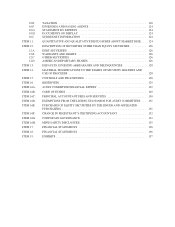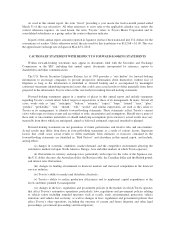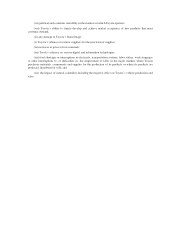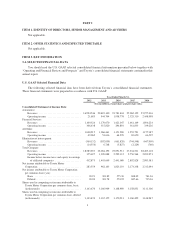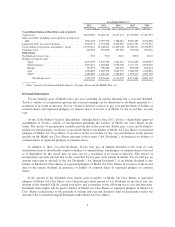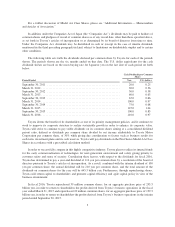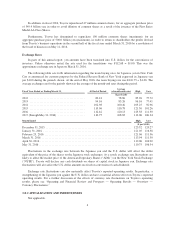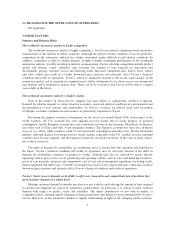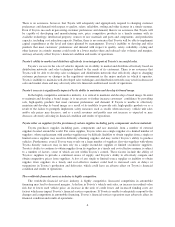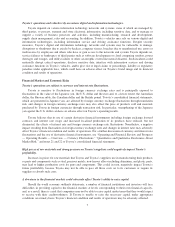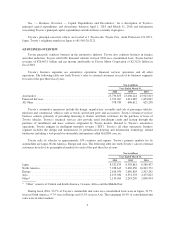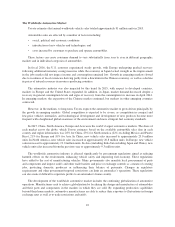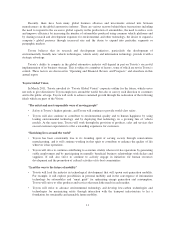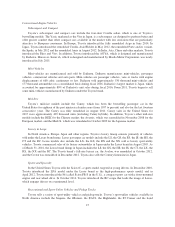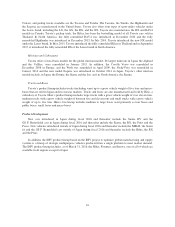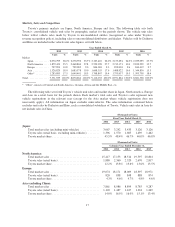Toyota 2015 Annual Report Download - page 13
Download and view the complete annual report
Please find page 13 of the 2015 Toyota annual report below. You can navigate through the pages in the report by either clicking on the pages listed below, or by using the keyword search tool below to find specific information within the annual report.Political, Regulatory, Legal and Other Risks
The automotive industry is subject to various governmental regulations.
The worldwide automotive industry is subject to various laws and governmental regulations including those
related to vehicle safety and environmental matters such as emission levels, fuel economy, noise and pollution. In
particular, automotive manufacturers such as Toyota are required to implement safety measures such as recalls
for vehicles that do not or may not comply with the safety standards of laws and governmental regulations. In
addition, Toyota may, in order to reassure its customers of the safety of Toyota’s vehicles, decide to voluntarily
implement recalls or other safety measures even if the vehicle complies with the safety standards of relevant laws
and governmental regulations. Many governments also impose tariffs and other trade barriers, taxes and levies, or
enact price or exchange controls. Toyota has incurred, and expects to incur in the future, significant costs in
complying with these regulations. If Toyota launches products that result in safety measures such as recalls,
Toyota may incur various costs including significant costs for free repairs. Furthermore, new legislation or
changes in existing legislation may also subject Toyota to additional expenses in the future. If Toyota incurs
significant costs related to implementing safety measures or meeting laws and governmental regulations,
Toyota’s financial condition and results of operations may be adversely affected.
Toyota may become subject to various legal proceedings.
As an automotive manufacturer, Toyota may become subject to legal proceedings in respect of various
issues, including product liability and infringement of intellectual property. Toyota may also be subject to legal
proceedings brought by its shareholders and governmental proceedings and investigations. Toyota is in fact
currently subject to a number of pending legal proceedings and government investigations. A negative
outcome in one or more of these pending legal proceedings could adversely affect Toyota’s financial condition
and results of operations. For a further discussion of governmental regulations, see “Information on the
Company — Business Overview — Governmental Regulation, Environmental and Safety Standards” and for
legal proceedings, please see “Information on the Company — Business Overview — Legal Proceedings.”
Toyota may be adversely affected by natural calamities, political and economic instability, fuel shortages or
interruptions in social infrastructure, wars, terrorism and labor strikes.
Toyota is subject to various risks associated with conducting business worldwide. These risks include
natural calamities; political and economic instability; fuel shortages; interruption in social infrastructure
including energy supply, transportation systems, gas, water, or communication systems resulting from natural
hazards or technological hazards; wars; terrorism; labor strikes and work stoppages. Should the major markets in
which Toyota purchases materials, parts and components and supplies for the manufacture of Toyota products or
in which Toyota’s products are produced, distributed or sold be affected by any of these events, it may result in
disruptions and delays in the operations of Toyota’s business. Should significant or prolonged disruptions or
delays related to Toyota’s business operations occur, it may adversely affect Toyota’s financial condition and
results of operations.
ITEM 4. INFORMATION ON THE COMPANY
4.A HISTORY AND DEVELOPMENT OF THE COMPANY
Toyota Motor Corporation is a limited liability, joint-stock company incorporated under the Commercial
Code of Japan and continues to exist under the Companies Act. Toyota commenced operations in 1933 as the
automobile division of Toyota Industries Corporation (formerly, Toyoda Automatic Loom Works, Ltd.). Toyota
became a separate company on August 28, 1937. In 1982, the Toyota Motor Company and Toyota Motor Sales
merged into one company, the Toyota Motor Corporation of today. As of March 31, 2016, Toyota operated
through 548 consolidated subsidiaries (including variable interest entities) and 200 affiliated companies, of which
54 companies were accounted for through the equity method.
8


